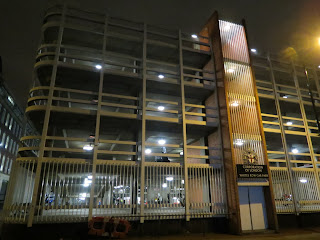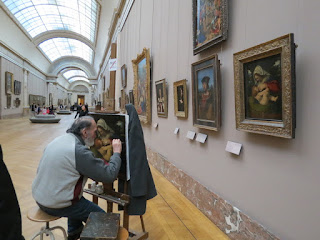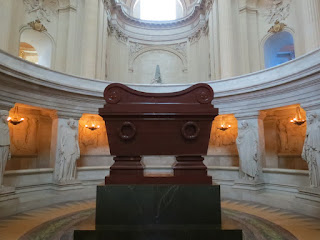Nope, not that one. I mean London. The British Empire spanned the globe. It held sway in dozens of countries and, along with the other European nations, sliced the world up into bits. Eventually, of course they came to realize they couldn't just go out and take the world, and they shrank themselves back to their little island off the coast of Europe. But the capital city, London, has remained an influential city ever since. And it's a large part of Canada's past and present. I really should have visited it long ago, but the urge just never took me. And in truth, if not for wanting to get home from the other direction, and for the really cheap fares to Canada from London, I wouldn't have come now.
But I have another reason for coming. One of my old hiking club buddies from Korea lives here and I thought it would be a good chance to meet him again. He thought it was a good idea as well, and when I said I was coming to London, he suggested we meet for coffee. He doesn't actually live in London, but about an hour away by train, so we made a plan to meet at one of the train stations in London.
We met. It was noon actually, so instead of coffee, I thought we could have lunch. Fish and chips, a good old fashioned English meal. We talked and caught up and then he paid for lunch, as a guest in the country. He didn't need to do that, but thank you Narian!!!
 Then I was off to see some of London. As I had discovered the night before upon arriving in London, it's a very walkable city. In fact, I had left my rooming house at around 9 and meandered my way to meet Narian for lunch. I could easily have gotten there in about an hour, but I took almost three. Along the way I found Buckingham Palace.
Then I was off to see some of London. As I had discovered the night before upon arriving in London, it's a very walkable city. In fact, I had left my rooming house at around 9 and meandered my way to meet Narian for lunch. I could easily have gotten there in about an hour, but I took almost three. Along the way I found Buckingham Palace. Canada Gate, but there's an Australia Gate as well, just opposite.
I went to the palace fence and looked through to watch the palace guard pacing back and forth. (This one looked a bit like a child dressed in adults clothing. He actually gave me the impression of Pooh Bear walking back and forth. I'm not sure why.) Unfortunately because it was winter, the changing of the guard only took place every other day, and this was not one of them. That's probably a good thing as the changing of the guard ceremony takes place at 11:30 and that would have been too late to watch it and still meet Narian. It was going to be done the next day at 11:30, so I decided to give it some thought whether I would brave the undoubtedly huge crowds that would be jostling for position. There were lots of other more interesting things I could think of doing, but if I had a bit of spare time, I thought I might try to check it out.
 I also found the theater that has been playing Agatha Christie's The Mousetrap for almost 60 years in the world's longest run of any live show, and actually probably all shows of any type, ever. I thought I would definitely be trying to see that one as well. I hoped it wouldn't be too expensive.
I also found the theater that has been playing Agatha Christie's The Mousetrap for almost 60 years in the world's longest run of any live show, and actually probably all shows of any type, ever. I thought I would definitely be trying to see that one as well. I hoped it wouldn't be too expensive.And just before meeting Narian, I found Hyde Park.
 After meeting Narian, I headed down to the river. On the way, I happened across Westminster Abbey. It was a grand old structure with flying buttresses. I would have gone in to have a look, but they had a hefty entrance fee of 16 pounds, almost 25 dollars. That seems to be a very high opinion they have of themselves. And besides that, churches are supposed to be free. If they want to ask for donations, that's one thing, but churches are supposed to be free. So I passed. I did take a photo from outside though.
After meeting Narian, I headed down to the river. On the way, I happened across Westminster Abbey. It was a grand old structure with flying buttresses. I would have gone in to have a look, but they had a hefty entrance fee of 16 pounds, almost 25 dollars. That seems to be a very high opinion they have of themselves. And besides that, churches are supposed to be free. If they want to ask for donations, that's one thing, but churches are supposed to be free. So I passed. I did take a photo from outside though. I headed on to the Thames. When I was in Egypt and visited Karnak Temple in Luxor, our tour guide told us that there used to be 8 obelisks in the temple. Five had ended up in cities around the world, while two had remained standing at the temple and one had fallen over. One of the obelisks had gone to France. I had seen that one.
Another had gone to London, and I wanted to see it as well. I asked where it was at one of the many London tourism offices. They are excellent. They are friendly and very informative. The guy in the office showed me where I could find the obelisk, which had been given the name of Cleopatra's Needle.
It turned out to be quite easy to find. But it has not been given nearly the same level of importance that the one in Paris has been given. In Paris, the obelisk sits on the Champs Elysees, in the middle of an intersection, in line with the arches, and the ugly carousel wheel. It's lit up at night.
In London, it is sitting by the river, in an out of the way place, not neglected, but not well respected either. Nevertheless, I've seen two of them now.
Then I continued down the riverbank of the Thames. I followed it along for quite a while, for about 4 kilometers as it turned out. It's quite a nice walk in many respects, although there is a lot of work going on at the moment that interferes with the path. In the runup to the Olympics this summer, there is much going on.
I was headed more or less in the direction of The Tower of London and of the Tower Bridge. They are near the Tower Hill tube (the name of the London subway system) station, which is where I was going to meet a walking tour, one of the famous London Walks. The one I was particularly interested in was the Jack the Ripper walk. The tour goes everyday at 7:30. I had a bunch of time, so I checked out The Tower of London and the The Tower Bridge.
The Tower of London is one of the castles of London and is famous for its dreadful goings on, with beheadings and gruesome dungeons and in particular for one of its most famous victims, Anne Boleyn, beheaded by order of her illustrious husband, Henry VIII.
I arrived as night had fallen, and the time for actually visiting the two was past, but I checked out the ticket office locations in case I felt I had time another day. And of course I took some photos against the night.
 After getting some dinner, I met the tour at the tube station and got out to see the haunt of old Jack. We began just past the remnant of an old London wall, the boundary between the well-to-do part of the central business district and the posh west side, and the destitute, impoverished, decrepit east side. From this side we were where the poverty began. It was the factory area, the area where people who couldn't do anything else found themselves. They were forced to do many things, from working in workhouses to prostitution. This was the area where Jack the Ripper did his work, terrorising the residents and confounding the police for four months while he killed and cut up five victims, becoming the first recorded serial killer.
After getting some dinner, I met the tour at the tube station and got out to see the haunt of old Jack. We began just past the remnant of an old London wall, the boundary between the well-to-do part of the central business district and the posh west side, and the destitute, impoverished, decrepit east side. From this side we were where the poverty began. It was the factory area, the area where people who couldn't do anything else found themselves. They were forced to do many things, from working in workhouses to prostitution. This was the area where Jack the Ripper did his work, terrorising the residents and confounding the police for four months while he killed and cut up five victims, becoming the first recorded serial killer. ...even if the exact places don't really look like they did, or have been turned into parking structures nowadays.
...even if the exact places don't really look like they did, or have been turned into parking structures nowadays. We were given a bunch of the current theories about who really was Jack the Ripper. (This included the now firmly believed idea that the name of Jack the Ripper was actually coined by a newspaper journalist who wanted to sensationalize the story. So it is now thought that this journalist wrote the two letters that were purportedly sent to the newspaper in question, posted them himself, and then wrote up the story, all in an attempt to boost circulation. Hmmm... Dirty dealings by London press. I'm shocked.) But we had a really good walk through the streets of a dark and lonely London. It was a great walk.
Following the walk, I returned to the rooming house. I had been away all day and it was time for a good night's sleep.























































































